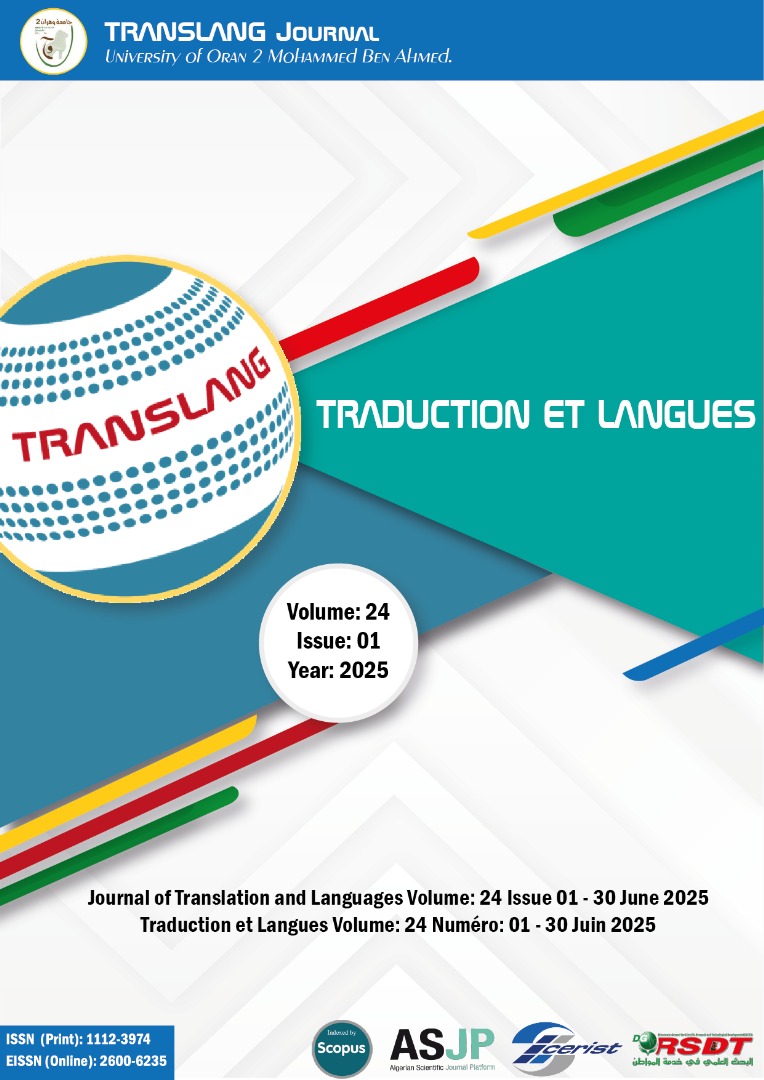Exploring Students’ Attitudes Towards The Implementation of Collaborative Writing: The case of 3rd Year students at Oran2 University
Main Article Content
Abstract
Collaborative learning is a crucial social-affective strategy in EFL classes, fostering shared expertise and decision-making among researchers in knowledge construction and language skills development, especially in academic writing. Good writing calls for good writing techniques, including collaborative writing. This approach encourages teamwork, critical thinking, and active engagement towards creating a well-structured piece of writing. Using collaborative writing in the classroom makes students more involved in all the writing processes—that is, in brainstorming ideas, compiling and arranging data, drafting, editing, and rewriting. Thus, the current investigation examines the attitudes and experiences of third-year English as a Foreign Language (EFL) students at the University of Oran 2, Algeria, toward collaborative writing and its effect on overcoming writing limitations. Using a mixed-methods approach, the researcher collected data through a four-section questionnaire administered to one hundred (100) students, semi-structured observations of collaborative writing projects, and analysis of student-generated essays. The quantitative analysis revealed that most students had participated in collaborative writing tasks. Though they had some reservations about time constraints and unequal participation, students generally expressed positive attitudes towards its advantages of English language learning and error correction. Qualitative data highlighted different interaction patterns and the negotiation of meaning within the group. Analyzing students’ papers revealed notable increases in organizational skills, comprehension and analysis, production standards, and discourse coherence. Although students preferred group projects to individual assignments, issues with group coordination and unequal contribution became clear as primary concerns for pedagogical relevance. The study found that the students often struggle with academic writing due to various reasons. However, implementing collaborative writing positively impacted students' attitudes towards academic writing, especially for weaker and average students. This approach helped overcome challenges such as time constraints, understanding objectives, structuring, presentation, and methodological issues. Collaborative writing significantly improved students' logical structure, clarity, understanding, analysis, production standards, and communication skills. The results imply that, in this EFL environment, collaborative writing has a significant potential to improve academic writing abilities; nevertheless, organized implementation is necessary to address the inherent challenges.
Metrics
Article Details
References
Allen, N., Atkinson, D., Morgan, M., Moore, T., & Snow, C. (1987). What experienced collaborators say about collaborative writing. Journal of Business and Technical Communication, 1(2), 70–90.
Breen, M. P., & Littlejohn, A. (Eds.). (2000). Classroom decision-making: Negotiation and process of syllabuses in practice. Cambridge University Press.
Hafid, N., & Gandana, I. (2021). EFL teachers’ perception and challenges in implementing collaborative writing. IDEAS: Journal on English Language Teaching and Learning, Linguistics and Literature, 9, 175–186. https://doi.org/ 10.24256/ideas.v9i2.2173
Holmes, J. (2000). Politeness, power and provocation: How humour functions in the workplace. Discourse Studies, 2(2), 159–185.
Hyland, K., & Hyland, F. (Eds.). (2006a). Feedback in second language writing: Contexts and issues. Cambridge University Press.
Hyland, K. (2003). Second language writing. Cambridge University Press.
Khamouja, A. (2025). The impact of collaborative writing strategy on EFL students’ writing skills through adopting a process-based approach. International Journal of Language and Literary Studies, 7(3), 169–179. https://doi.org/ 10.36892/ ijlls. v7i3. 2137
Latifah, U., Maria Ulfa, S., & Rachmawati, I. (2020). The effectiveness of using collaborative writing strategy for writing ability of senior high school students. SELL (Scope of English Language Teaching, Linguistics, and Literature) Journal, 5(1), 1–18. https://publikasi.stkippgri-bkl.ac.id/index.php/SL/article/view/315
Manchón, R. M., Roca de Larios, J., & Murphy, L. (2000). An approximation to the study of backtracking in L2 writing. Learning and Instruction, 10(1), 13–35.
Nation, P. (2003). The role of the first language in foreignlanguage learning. The Asian EFL Journal. https://www.asian-efl-journal.com/june_2003_pn.pdf
Ohta, A. S. (2001). Peer interactive tasks and assisted performance in classroom language learning. In A. S. Ohta (Ed.), Second language acquisition processes in the classroom: Learning Japanese (pp. 73–128). Lawrence Erlbaum.
Pardede, P. (2024). Collaborative writing in EFL settings: A review. Journal of English Teaching, 10(1), 92–109. https://doi.org/10.33541/jet.v10i1.5631
Qi, D. S. (1998). An inquiry into language-switching in second language composing. The Canadian Modern Language Review, 54, 413–435.
Sajedi, S. (2014). Collaborative writing summary and EFL students’ L2 development. Procedia - Social and Behavioral Sciences, 98, 1650–1657. https://doi.org/ 10.1016/ j.sbspro.2014.03.589
Tocalli-Beller, A. (2003). Cognitive conflict, disagreement and repetition in collaborative groups: Affective and social dimensions from an insider’s perspective. The Canadian Modern Language Review, 60(2), 143–171.
Van, C. H. T., & Tran, T. T. M. (2023). VLU EFL students’ perceptions towards the use of collaborative writing. International Journal of TESOL & Education, 3(3), 57–77. https://doi.org/10.54855/ijte.23334
Veramuthu, P., & Shah, P. M. (2020). Effectiveness of collaborative writing among secondary school students in an ESL classroom. Creative Education, 11(1), 54–67. https://doi.org/10.4236/ce.2020.111004
Wenger, E. (1998). Communities of practice: Learning, meaning and identity. Cambridge University Press.
Yong, M. (2010). Collaborative writing features. RELC Journal, 41, 18–30. https://doi.org/10.1177/0033688210362610
